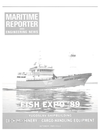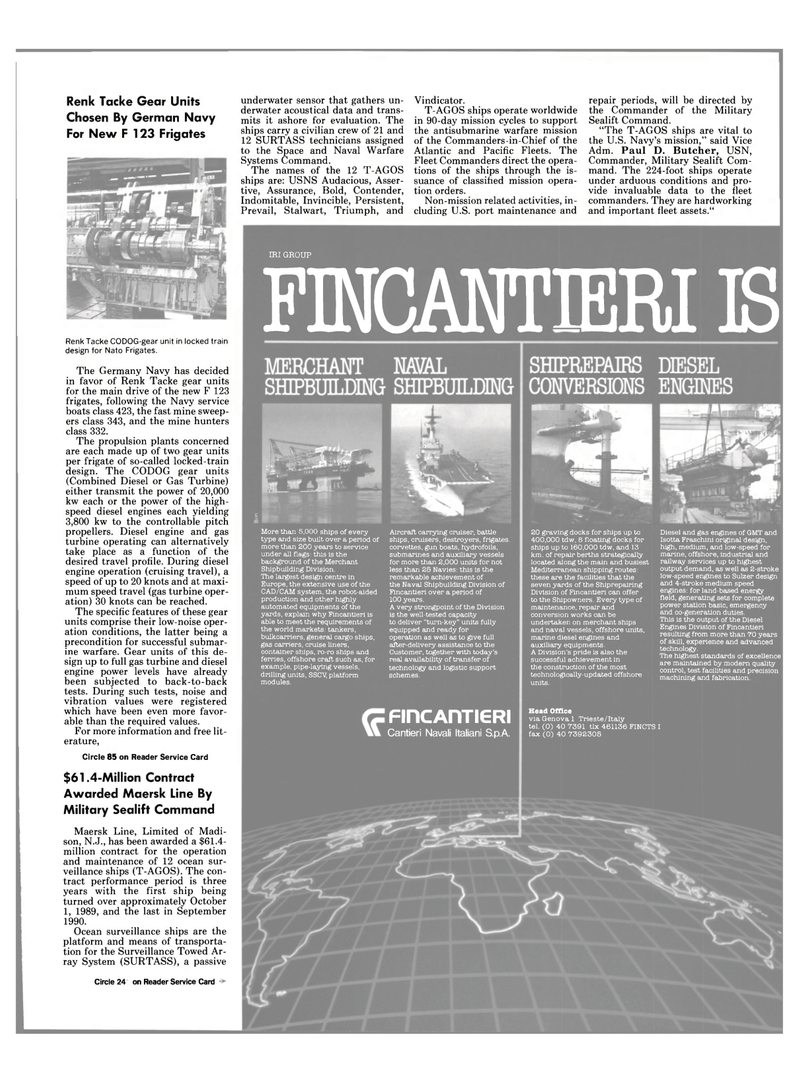
Page 33: of Maritime Reporter Magazine (October 1989)
Read this page in Pdf, Flash or Html5 edition of October 1989 Maritime Reporter Magazine
Renk Tacke Gear Units
Chosen By German Navy
For New F 123 Frigates underwater sensor that gathers un- derwater acoustical data and trans- mits it ashore for evaluation. The ships carry a civilian crew of 21 and 12 SURTASS technicians assigned to the Space and Naval Warfare
Systems Command.
The names of the 12 T-AGOS ships are: USNS Audacious, Asser- tive, Assurance, Bold, Contender,
Indomitable, Invincible, Persistent,
Prevail, Stalwart, Triumph, and
Vindicator.
T-AGOS ships operate worldwide in 90-day mission cycles to support the antisubmarine warfare mission of the Commanders-in-Chief of the
Atlantic and Pacific Fleets. The
Fleet Commanders direct the opera- tions of the ships through the is- suance of classified mission opera- tion orders.
Non-mission related activities, in- cluding U.S. port maintenance and repair periods, will be directed by the Commander of the Military
Sealift Command. "The T-AGOS ships are vital to the U.S. Navy's mission," said Vice
Adm. Paul D. Butcher, USN,
Commander, Military Sealift Com- mand. The 224-foot ships operate under arduous conditions and pro- vide invaluable data to the fleet commanders. They are hardworking and important fleet assets."
Renk Tacke CODOG-gear unit in locked train design for Nato Frigates.
The Germany Navy has decided in favor of Renk Tacke gear units for the main drive of the new F 123 frigates, following the Navy service boats class 423, the fast mine sweep- ers class 343, and the mine hunters class 332.
The propulsion plants concerned are each made up of two gear units per frigate of so-called locked-train design. The CODOG gear units (Combined Diesel or Gas Turbine) either transmit the power of 20,000 kw each or the power of the high- speed diesel engines each yielding 3,800 kw to the controllable pitch propellers. Diesel engine and gas turbine operating can alternatively take place as a function of the desired travel profile. During diesel engine operation (cruising travel), a speed of up to 20 knots and at maxi- mum speed travel (gas turbine oper- ation) 30 knots can be reached.
The specific features of these gear units comprise their low-noise oper- ation conditions, the latter being a precondition for successful submar- ine warfare. Gear units of this de- sign up to full gas turbine and diesel engine power levels have already been subjected to back-to-back tests. During such tests, noise and vibration values were registered which have been even more favor- able than the required values.
For more information and free lit- erature,
Circle 85 on Reader Service Card
ERI GROUP mCAMTERIE
More than 5,000 ships of every type and size built over a period of more than 200 years to service under all flags: this Is the background of the Merchant
Shipbuilding Division.
The largest design centre in
Europe, the extensive use of the
CAD/CAM system, the robot-aided production and other highly automated equipments of the yards, explain why Pincantieri is able to meet the requirements of the world markets: tankers, bulkcarriers, general cargo ships, gas carriers, cruise liners, container ships, ro-ro ships and ferries, offshore craft such as, for example, pipe-laying vessels, drilling units, SSCy platform modules.
Aircraft carrying cruiser, battle ships, cruisers, destroyers, frigates, corvettes, gun boats, hydrofoils, submarines and auxiliary vessels for more than 2,000 units for not less than 25 Navies: this Is the remarkable achievement of the Naval Shipbuilding Division of
Pincantieri over a period of 100 years.
A very strongpoint of the Division is the well-tested capacity to deliver "turn-key" units fully equipped and ready for operation as well as to give full after-delivery assistance to the
Customer, together with today's real availability of transfer of technology and logistic support schemes. 20 graving docks for ships up to 400,000 tdw, 8 floating docks for ships up to 160,000 tdw, and 13 km. of repair berths strategically located along the main and busiest
Mediterranean shipping routes: these are the facilities that the seven yards of the Shiprepairing
Division of Fincantleri can offer to the Shipowners. Eveiy type of maintenance, repair and conversion works can be undertaken on merchant ships and naval vessels, offshore units, marine diesel engines and auxiliary equipments.
A Division's pride is also the successful achievement in the construction of the most technologically-updated offshore units.
Diesel and gas engines of GMT and
Isotta Fraschini original design, high, medium, and low-speed for marine, offshore, industrial and railway services up to highest output demand, as well as 2-stroke low-speed engines to Sulzer design and 4-stroke medium speed engines: for land-based energy field, generating sets for complete power station basic, emergency and co-generation duties.
This is the output of the Diesel
Engines Division of Fincantleri resulting from more than 70 years of skill, experience and advanced technology.
The highest standards of excellence are maintained by modern quality control, test facilities and precision machining and fabrication.
Head Office viaGenoval Trieste/Italy tel. (0) 40 7391 tlx 461136 FINCTS I fax (0) 40 7392305
FinCAnTIGRI
Cantieri Navali Italiani S.p.A. $61,4-Million Contract
Awarded Maersk Line By
Military Sealift Command
Maersk Line, Limited of Madi- son, N.J., has been awarded a $61.4- million contract for the operation and maintenance of 12 ocean sur- veillance ships (T-AGOS). The con- tract performance period is three years with the first ship being turned over approximately October 1, 1989, and the last in September 1990.
Ocean surveillance ships are the platform and means of transporta- tion for the Surveillance Towed Ar- ray System (SURTASS), a passive
Circle 245 on Reader Service Card

 32
32

 34
34
